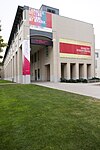Main Building, U.S. Bureau of Mines
Allegheny County, Pennsylvania Registered Historic Place stubsBeaux-Arts architecture in PennsylvaniaBuildings and structures in PittsburghCarnegie Mellon UniversityGovernment buildings completed in 1919 ... and 5 more
Government buildings on the National Register of Historic Places in PennsylvaniaHenry Hornbostel buildingsNational Register of Historic Places in PittsburghPittsburgh History & Landmarks Foundation Historic LandmarksPittsburgh building and structure stubs

The Main Building of the U.S. Bureau of Mines in the Squirrel Hill North neighborhood of Pittsburgh, Pennsylvania is a building constructed from 1915 and dedicated on September 29, 1919. Since the 1960s it was acquired and has been part of the campus of Carnegie Mellon University and is now known as Hamburg Hall and the headquarters of the Heinz College. It was listed on the National Register of Historic Places in 1974.
Excerpt from the Wikipedia article Main Building, U.S. Bureau of Mines (License: CC BY-SA 3.0, Authors, Images).Main Building, U.S. Bureau of Mines
South Dithridge Street, Pittsburgh
Geographical coordinates (GPS) Address Nearby Places Show on map
Geographical coordinates (GPS)
| Latitude | Longitude |
|---|---|
| N 40.444166666667 ° | E -79.945833333333 ° |
Address
Carnegie Mellon University
South Dithridge Street
15213 Pittsburgh
Pennsylvania, United States
Open on Google Maps








